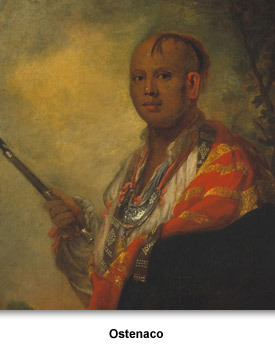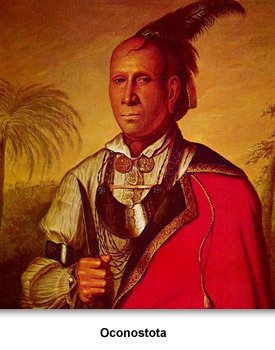Indians & Cultural Encounters
Cherokee Contact
Although Hernando de Soto’s expedition had crossed Cherokee lands in 1540, the Cherokee didn’t have much contact with Europeans until the 1700s. This was partly because Cherokees lived in farming hamlets in isolated valleys in the Appalachian mountain region.
With the booming trade in deerskins, the Cherokee began a close relationship with the British. They traded deerskins for firearms, ammunition, and other trade goods. The firearms proved important as the Cherokee used them to successfully drive out other tribes and expand their territory, moving into what is now East Tennessee. This meant they could secure even more deerskins.
With the booming trade in deerskins, the Cherokee began a close relationship with the British. They traded deerskins for firearms, ammunition, and other trade goods. The firearms proved important as the Cherokee used them to successfully drive out other tribes and expand their territory, moving into what is now East Tennessee. This meant they could secure even more deerskins.
This movement of Cherokees into Tennessee lands held by other tribes was evident when Lt. Henry Timberlake visited the area in 1762. Most of the towns still had Muskogean names even though Cherokee-speaking people lived there.
These East Tennessee Cherokee towns were known as the Overhill towns. They became a series of culturally related villages. They were located along the Hiwassee and Little Tennessee River systems from the late 1600s until 1838, when the Cherokees were forced to relocate to Oklahoma.
In 1730, six Cherokee men were taken to England, and met with King George II. While there, they signed a treaty that brought the Cherokee people under the control and protection of the English.
The leader of the group was a Cherokee from Tennessee named Attakullakulla, which means “Little Carpenter.” On returning home, they remained committed to the treaty and did what they could to help the English.
Not all Cherokees agreed with them, however. For instance, a Cherokee warrior named Oconastota hated the English. He believed that the English had deliberately spread smallpox to decimate the Indian population.
Through trade, the Cherokee and British forged a strong alliance in the first part of the 1700s. The Cherokee were dependent upon British trade goods, while the British needed the Cherokee as a defense against French attacks.
This alliance lasted until the French and Indian War. The British, using the Treaty of 1730, demanded that the Cherokee fight against their enemies, the French. The Cherokee agreed, but the alliance was broken over a violent confrontation between settlers and the Indians. Differences in cultural beliefs caused a division between the two allies that was ultimately more damaging to the Cherokee.
Find out more about Cherokee leaders who lived in the 1700s.
Picture Credits:
- Portrait of Ostenaco painted by Joshua Reynolds in 1762. Ostenaco was a Cherokee leader and part of the Cherokee delegation that traveled to England to improve relations between the two nations. He is pictured with a sliver gorget, an item that was given to Native American allies of the English. He also wears a medal that was given to him for his role in securing a peace treaty. Gilcrease Museum.
- Portrait of Oconostota, sometimes called Cunne Shote or Stalking Turkey, painted by Francis Parsons in 1762. Oconostota was a Cherokee Chief and part of the Cherokee delegation that traveled to England to improve relations between the two nations. Gilcrease Museum.
Indians & Cultural Encounters >> Contact and Conflict >> European Contact >> Cherokee Contact


 Sponsored by: National Endowment for the Humanities
Sponsored by: National Endowment for the Humanities